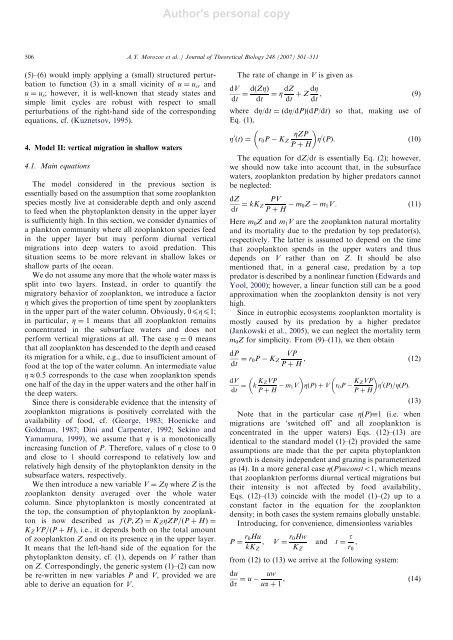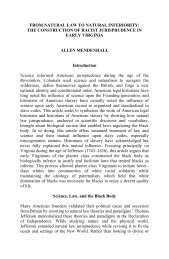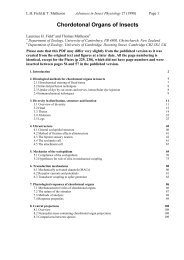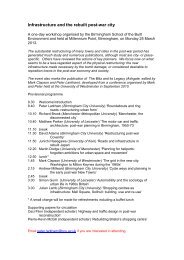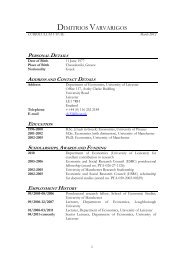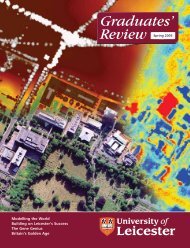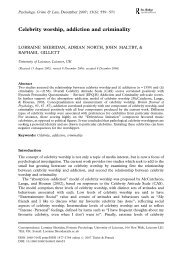Journal of Theoretical Biology 248, 501-511 - University of Leicester
Journal of Theoretical Biology 248, 501-511 - University of Leicester
Journal of Theoretical Biology 248, 501-511 - University of Leicester
You also want an ePaper? Increase the reach of your titles
YUMPU automatically turns print PDFs into web optimized ePapers that Google loves.
Author's personal copy506ARTICLE IN PRESSA.Y. Morozov et al. / <strong>Journal</strong> <strong>of</strong> <strong>Theoretical</strong> <strong>Biology</strong> <strong>248</strong> (2007) <strong>501</strong>–<strong>511</strong>(5)–(6) would imply applying a (small) structured perturbationto function (3) in a small vicinity <strong>of</strong> u ¼ u cr andu ¼ u s ; however, it is well-known that steady states andsimple limit cycles are robust with respect to smallperturbations <strong>of</strong> the right-hand side <strong>of</strong> the correspondingequations, cf. (Kuznetsov, 1995).4. Model II: vertical migration in shallow waters4.1. Main equationsThe model considered in the previous section isessentially based on the assumption that some zooplanktonspecies mostly live at considerable depth and only ascendto feed when the phytoplankton density in the upper layeris sufficiently high. In this section, we consider dynamics <strong>of</strong>a plankton community where all zooplankton species feedin the upper layer but may perform diurnal verticalmigrations into deep waters to avoid predation. Thissituation seems to be more relevant in shallow lakes orshallow parts <strong>of</strong> the ocean.We do not assume any more that the whole water mass issplit into two layers. Instead, in order to quantify themigratory behavior <strong>of</strong> zooplankton, we introduce a factorZ which gives the proportion <strong>of</strong> time spent by zooplanktersin the upper part <strong>of</strong> the water column. Obviously, 0pZp1;in particular, Z ¼ 1 means that all zooplankton remainsconcentrated in the subsurface waters and does notperform vertical migrations at all. The case Z ¼ 0 meansthat all zooplankton has descended to the depth and ceasedits migration for a while, e.g., due to insufficient amount <strong>of</strong>food at the top <strong>of</strong> the water column. An intermediate valueZE0.5 corresponds to the case when zooplankton spendsone half <strong>of</strong> the day in the upper waters and the other half inthe deep waters.Since there is considerable evidence that the intensity <strong>of</strong>zooplankton migrations is positively correlated with theavailability <strong>of</strong> food, cf. (George, 1983; Hoenicke andGoldman, 1987; Dini and Carpenter, 1992; Sekino andYamamura, 1999), we assume that Z is a monotonicallyincreasing function <strong>of</strong> P. Therefore, values <strong>of</strong> Z close to 0and close to 1 should correspond to relatively low andrelatively high density <strong>of</strong> the phytoplankton density in thesubsurface waters, respectively.We then introduce a new variable V ¼ ZZ where Z is thezooplankton density averaged over the whole watercolumn. Since phytoplankton is mostly concentrated atthe top, the consumption <strong>of</strong> phytoplankton by zooplanktonis now described as f ðP; ZÞ ¼K Z ZZP=ðP þ HÞ ¼K Z VP=ðP þ HÞ, i.e., it depends both on the total amount<strong>of</strong> zooplankton Z and on its presence Z in the upper layer.It means that the left-hand side <strong>of</strong> the equation for thephytoplankton density, cf. (1), depends on V rather thanon Z. Correspondingly, the generic system (1)–(2) can nowbe re-written in new variables P and V, provided we areable to derive an equation for V.The rate <strong>of</strong> change in V is given asdVdt ¼ dðZZÞ ¼ Z dZdt dt þ Z dZdt , (9)where dZ/dt ¼ (dZ/dP)(dP/dt) so that, making use <strong>of</strong>Eq. (1),Z 0 ZZPðtÞ ¼ r 0 P K ZP þ HZ 0 ðPÞ. (10)The equation for dZ/dt is essentially Eq. (2); however,we should now take into account that, in the subsurfacewaters, zooplankton predation by higher predators cannotbe neglected:dZdt ¼ kK PVZP þ H m 0Z m 1 V. (11)Here m 0 Z and m 1 V are the zooplankton natural mortalityand its mortality due to the predation by top predator(s),respectively. The latter is assumed to depend on the timethat zooplankton spends in the upper waters and thusdepends on V rather than on Z. It should be alsomentioned that, in a general case, predation by a toppredator is described by a nonlinear function (Edwards andYool, 2000); however, a linear function still can be a goodapproximation when the zooplankton density is not veryhigh.Since in eutrophic ecosystems zooplankton mortality ismostly caused by its predation by a higher predator(Jankowski et al., 2005), we can neglect the mortality termm 0 Z for simplicity. From (9)–(11), we then obtaindPdt ¼ r VP0P K ZP þ H , (12)dVdt ¼ k K ZVPP þ Hm 1V ZðPÞþV r 0 P K ZVPZ 0 ðPÞ=ZðPÞ.P þ H(13)Note that in the particular case Z(P)1 (i.e. whenmigrations are ‘switched <strong>of</strong>f’ and all zooplankton isconcentrated in the upper waters) Eqs. (12)–(13) areidentical to the standard model (1)–(2) provided the sameassumptions are made that the per capita phytoplanktongrowth is density independent and grazing is parameterizedas (4). In a more general case Z(P)consto1, which meansthat zooplankton performs diurnal vertical migrations buttheir intensity is not affected by food availability,Eqs. (12)–(13) coincide with the model (1)–(2) up to aconstant factor in the equation for the zooplanktondensity; in both cases the system remains globally unstable.Introducing, for convenience, dimensionless variablesP ¼ r 0Hu; V ¼ r 0Hwand t ¼ t ,kK Z K Z r 0from (12) to (13) we arrive at the following system:dudt ¼ uuwua þ 1 , (14)


